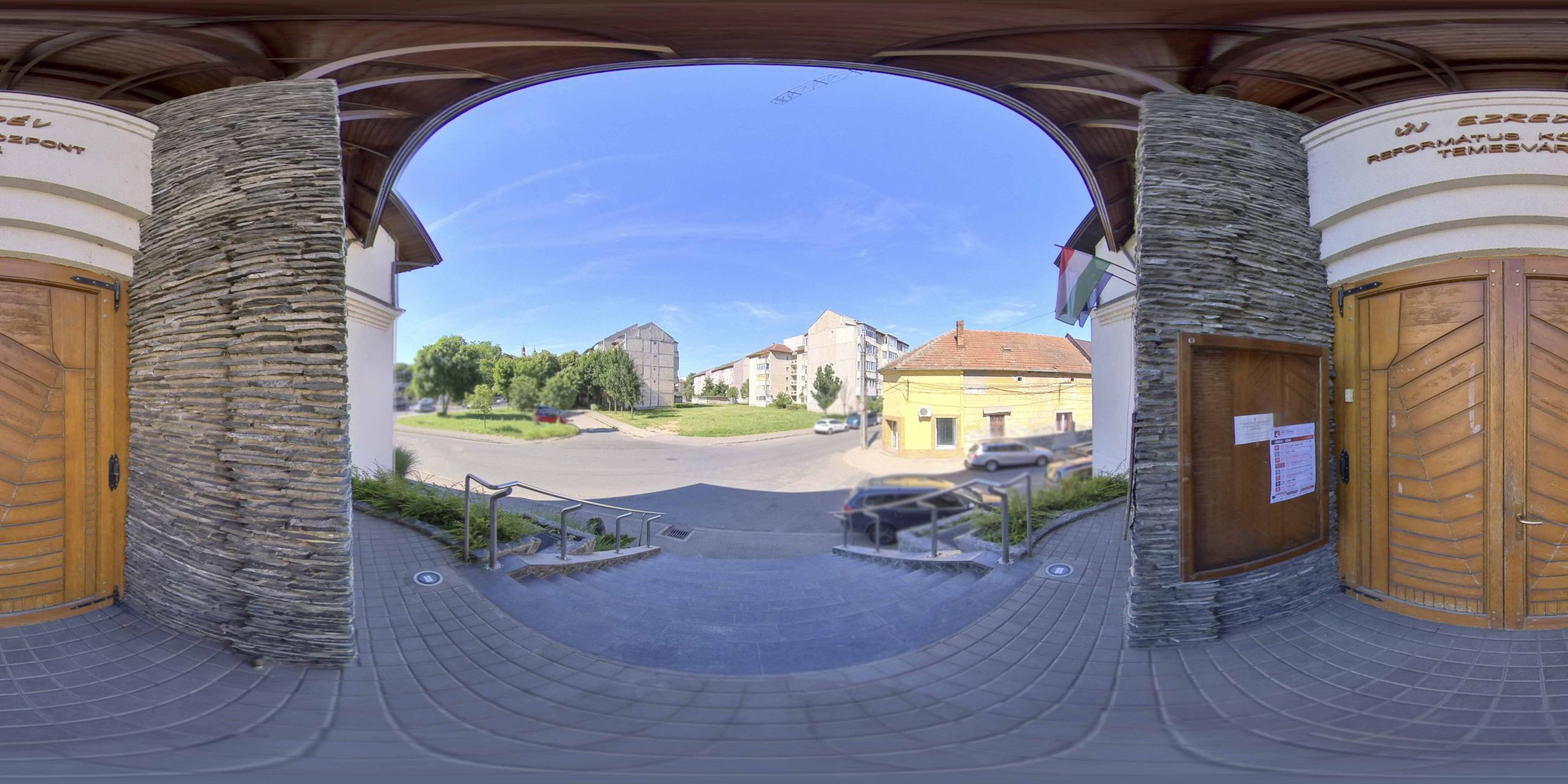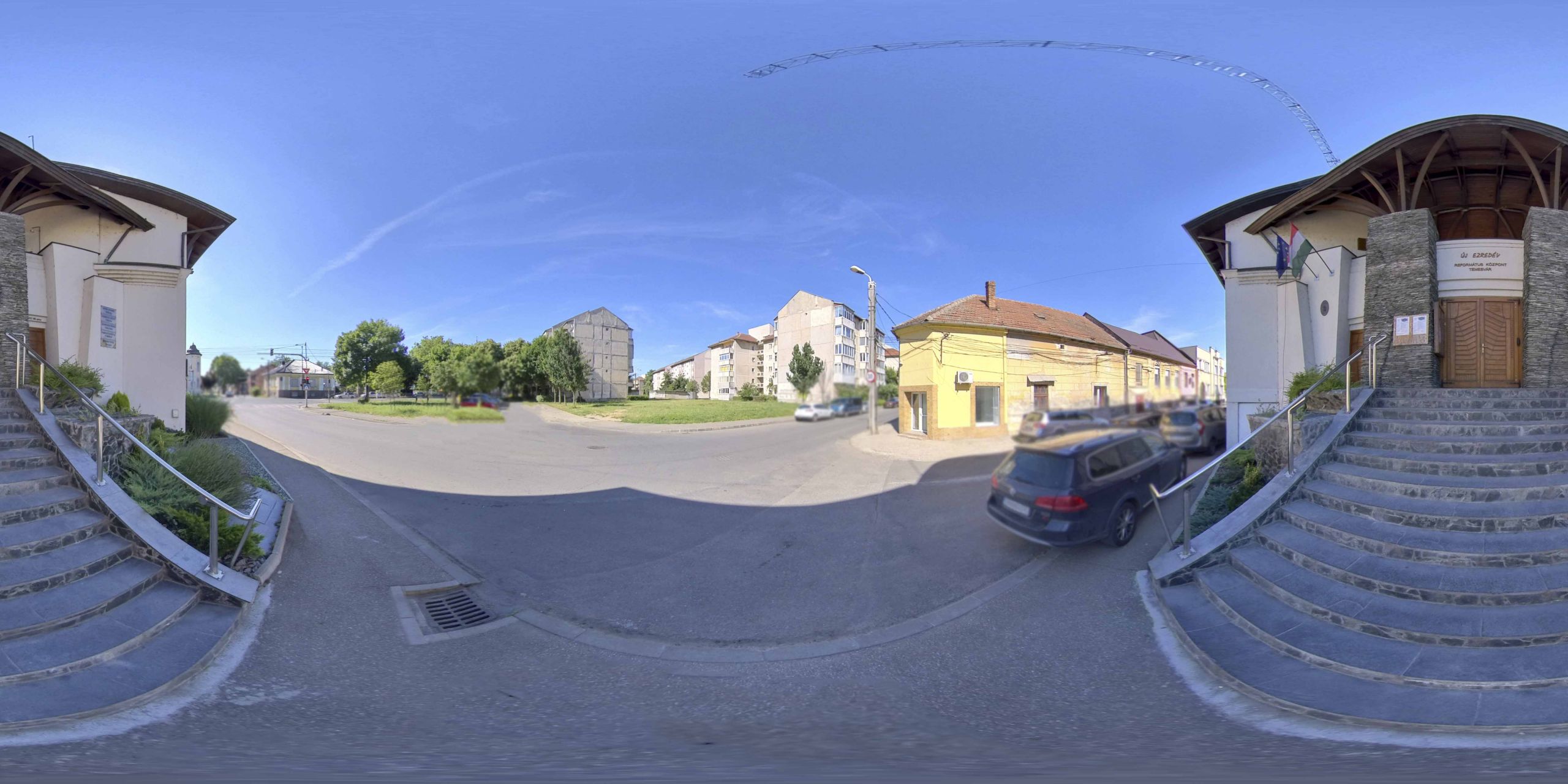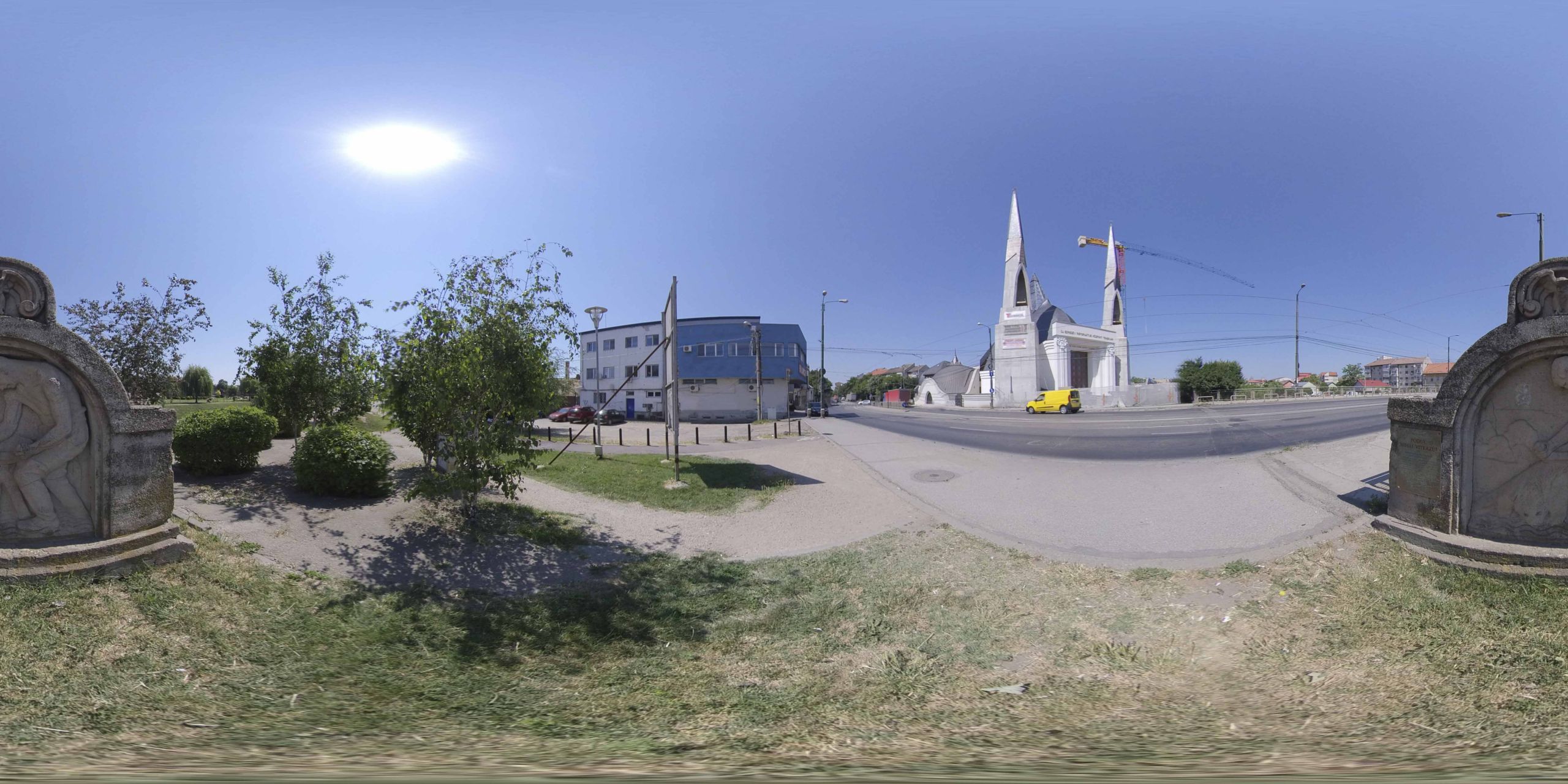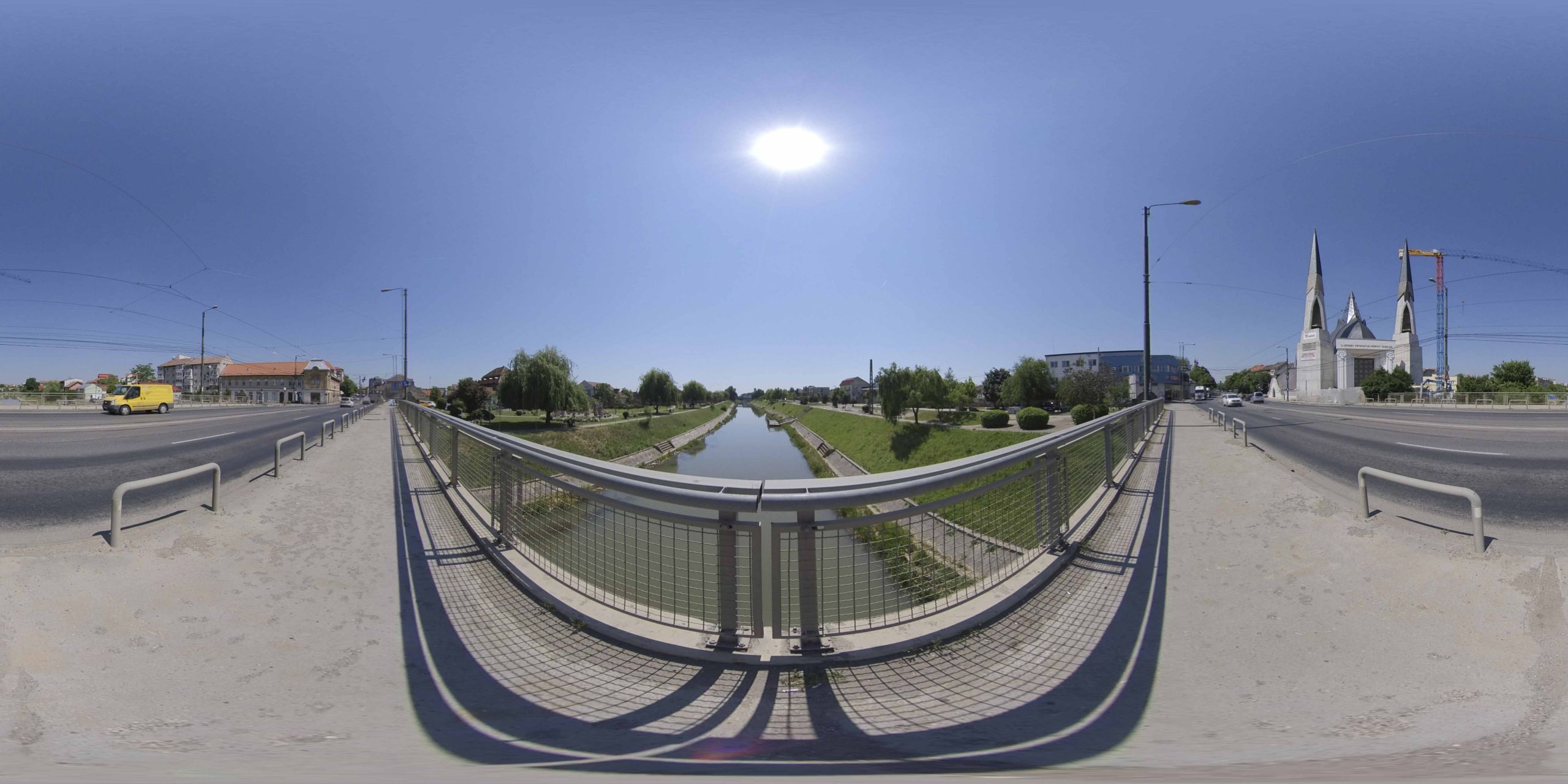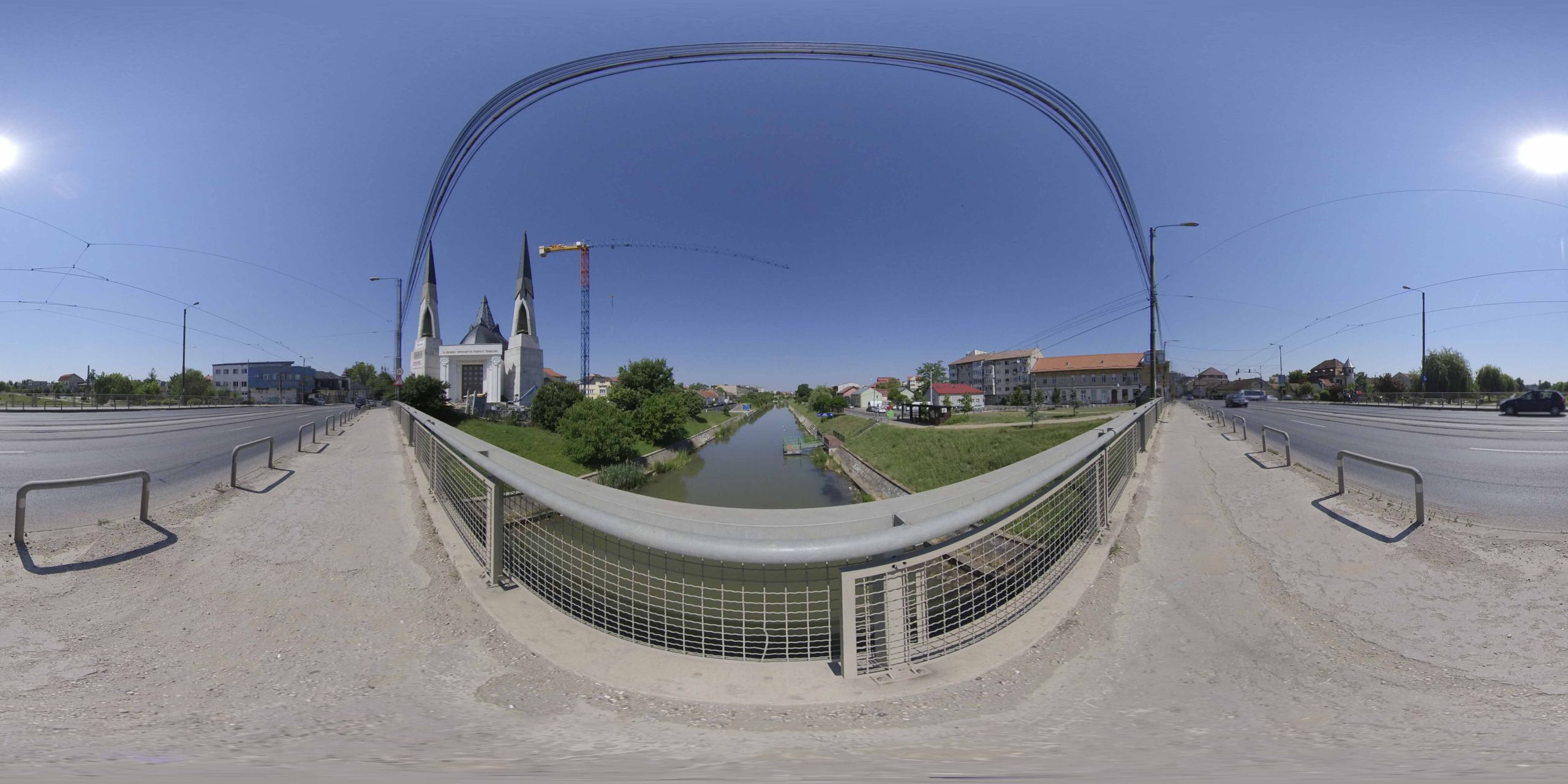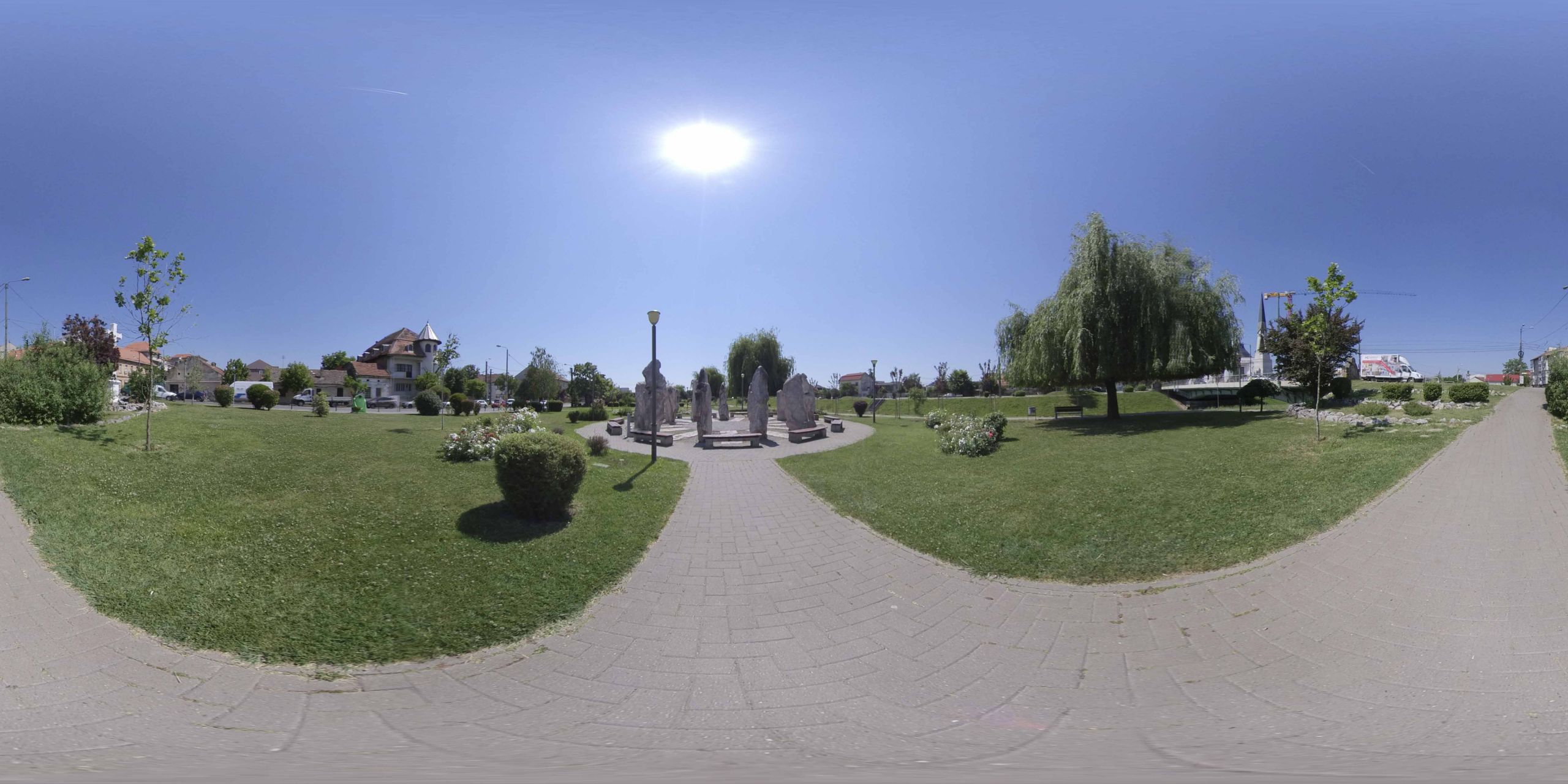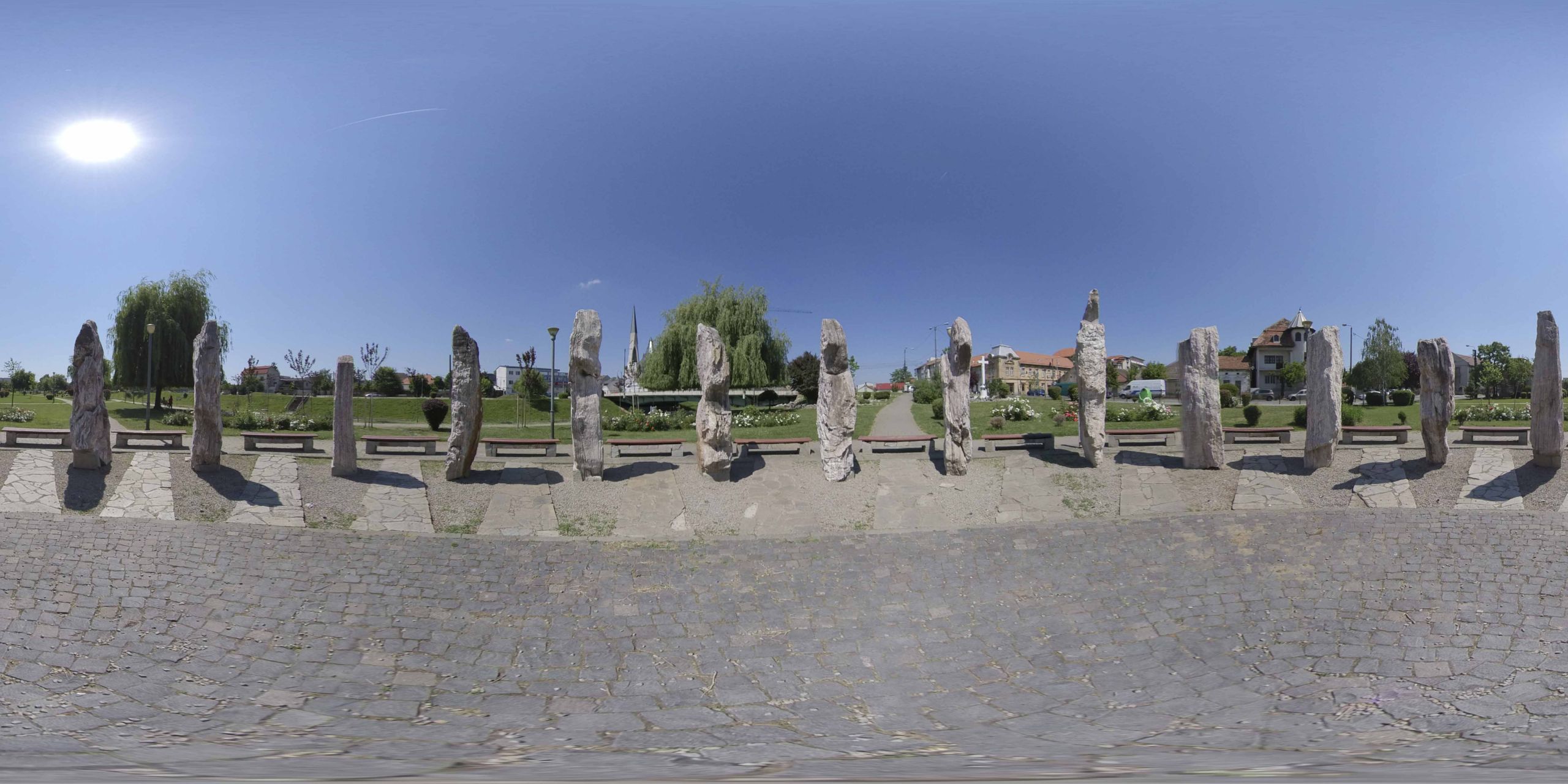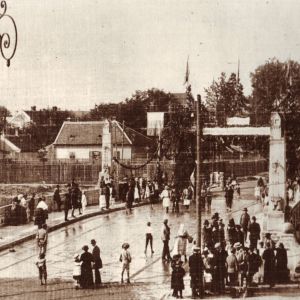The Mihai Viteazul Bridge
The bridge in Morii Square, built in 1908, was demolished in 1980 and replaced with a new bridge (today Mihai Viteazul Bridge). The designer of the new bridge was the engineer Dr. Radu Marinov from the Timișoara Design Institute, and the execution was carried out by the Timișoara Railway Construction Company. The new bridge was put into operation in 1981.
Listen to the audio version.
The project for the Bridge in Morii Square (today Mihai Viteazul) was drawn up by the design office of the Budapest university professor Kovács-Sebestény Aladár and the engineer Póka Rezső, and the architect of this bridge was Hikisch Rezső. The execution was carried out by the Budapest company Magyar Beton- és Vasbeton - Épitési Vállalat WAYSS G. A. és Társa, and the works took place during 1908.
For a more beautiful architecture of the bridge in Morii Square, the urban commission approved the proposal of the engineering office to apply a relief in the field of the pillars, which would reproduce the most important moments in the vicinity of the bridge. For this, the city gave another 1000 crowns to the construction company. The four reliefs were saved from destruction and placed on the new Mihai Viteazul bridge.
The bridge in Piata Morii was designed with a continuous beam structure. It had three openings (8 m + 31 m + 8 m) and a width of 15 m. To reduce the large positive moments in the field, the beam continued beyond the abutment by another 8 m, and at their end the cantilevers were full (on a length of almost 5 m), constituting the necessary counterweights. The main reinforcements were made of concrete with a diameter of 40 mm. The amount of 117,000 crowns was spent on the construction of the bridge.
The bridge in Morii Square was demolished in 1980 and replaced with a new bridge (today Mihai Viteazul Bridge).
The designer of the new bridge was the engineer, Dr. Radu Marinov, from the Timișoara Design Institute, and the execution was carried out by the Timișoara Railway Construction Company. The current Mihai Viteazul bridge has three openings (9.3 m + 31 m + 9.3 m) and a total length of almost 50 meters. The structural solution consists of two metal decks, each consisting of two caisson beams connected to each other by end spacers and intermediate transverse connections, ensuring high torsional rigidity and favorable load distribution. At the top, a 22 cm thick monolithic reinforced concrete slab was made, connected with rigid connectors to the metal deck.
Unfortunately, due to negligence in the location of the saved bas-reliefs of the dismantled bridge, their initial location was not respected. The bridge was put into service in 1981.
The Cultural Center and the New Millennium Reformed Church were recently built in the area of the bridge.
Bibliography:
Jancsó Árpád, History of the bridges in Timisoara, Mirton Publishing House, Timisoara, 2001, pp. 90-98, 227-229, 275.
The Mihai Viteazul Bridge
At the Turkish Prince
We soon reach a place called Chiukur's Garden. But that Ciukur was not Ciukur. That was Ceakir-bei's property. I think he was the Turkish governor of Blaşca Mare. This Ceakir-bei also had a property, a cafe where the Turkish Prince station is. There was a bridge over an arm of Bega that came from Sarmisegetusa Square and went around, passed the Brewery and flowed into Bega, where there is now a footbridge. The Romanian name of the Turkish Prince is closer to the truth than the German or Hungarian one. The German one is "Zum Türkischen Kaiser", which means "To the Turkish Emperor", and the Hungarians used to say "A Török Császár", which is about the same thing. But the bei could not be king. He could be a prince. It's about this Ceakir-bei. In the Turkish Prince were the slaughterhouses of lambs. These lamb slaughterhouses were again on anchored rafts, and blood flowed directly into the Bega through the rafts of the beams. I think a street there was once called Lämmerstraße, the lamb street. There were very few buildings on the other side of Take Ionescu Street until after the war. Here and there a villa. Today, on the edge of Ciukur's Garden, it is called Zurich Street.
George Vaida, born in 1926 - excerpt from the interview conducted by Smaranda Vultur in Timisoara 1998, The oral history and anthropology group archive, coordinated by Smaranda Vultur.
Sorina Jecza - 2 Zürich Street
Yesterday, a late, beautiful sparkle. On the streets you felt, however, the restlessness of the autumn that wanted to take hold: leaves, in an alert back and forth, yellow gilding the air - source of solar melancholy...
I'm going back to where I've been these days: 2 Zürich Street. Where do I get it from? Maybe from the yellow of the chestnut trees in the park.
Let me go down to the yard first. It stretched between the angles of the U-shaped building, only the base was much wider than the perpendicular sides. Into the courtyard you went, in fact, because the block had a basement. Part of it was inhabited: as you went down the few steps, immediately, on the right-hand side, was Aunt Welther, the porter of the block. She had the "block book" where all the tenants were registered. She had no husband. He had died sometime; I don't know when. She also had a son, Erwin or Walther, I don't know, who had also disappeared, maybe died. She was left with a daughter, Eva, much older than us. Of an age with Ada Erhan - with whom she was in some sort of competition... Eva remained unmarried. I never knew any of her knights. We sometimes went to Aunt Welther's. We went straight into the main room (there were two in total). There was always a cake waiting for us on the table. She talked a little. Very discreet. When my mother sent us the "block money", we always found her sewing something.
On the opposite side was the Toma family. The fear and terror of our childhood. He, uncle Toma, old - as he seemed to us, a former officer, was always on the lookout, to catch our slips. If, playing with the ball, we dropped it in the small corridor in front of his window, he was always faster than us. He'd grab the "object of crime", with which he'd then start endless negotiations. The stakes were to stop playing the boogeyman. Several times, the negotiations failed, and our ball, broken with a sharp object, whose aggressiveness we never managed to relate to the meaning we knew to be benign, ended their bouncing existence in a ridiculous apathetic deflation... For us, Uncle Thomas was, in a way, the very embodiment of the boogeyman. Once, on our way to the courtyard, we sneaked up on them, lest any of them notice us and alert their vigilance, and we became unwitting witnesses. Beyond the door, the frightened screams of the woman begging not to kill her. Running. Screaming, again... We hurried away, so as not to witness the massacre, retreating to the corner of the courtyard next to the laundry room where we couldn't be seen and whispering... A moment of intense tension. Later, we were no less surprised to see them together again, seemingly as serene as ever, joining forces to spy on us.
Also in the basement, entering from the corridor that enclosed the courtyard, after passing the Welther family windows, turning slightly to the right, was another small apartment, then, at the front, was the door that opened into the darkness of the real cellar, where each family had a storage space for their winter supplies. In that apartment lived Aunt Hajos. Quiet, small, she didn't have much to do with us. She spoke bad Romanian. I don't remember ever entering her house. I don't think she valued it much either. Hajos neni's real house, as we used to call her when we talked to Sari neni or Gizi neni about her, was in the courtyard. That's where she made up for the lack of space she didn't really enjoy in the basement. In front of her windows, on the small side of the U of the courtyard, the one on the right, she had planted a full row of hydrangeas. Rich, round, strong, they were seedier than their little garden, which projected in their strength like a more forgiving mirror. Hydrangeas were the form by which Hajos neni marked his existence in the block world. It was through them that he won the competition with Aunt Welther, who had also built her own green row. Aunt Welther, however, was dominated by boxwood, followed by the queen of the night, whose scent we became more attentive to in later years, because it brought a dreamy and mysterious scent...
The third "competitor" had his domain in the left half of the courtyard. There, the Toma family had put their tomatoes, the ones they were guarding from the danger that was us. It was also there that the young Aunt Peia, my friend Tavi's mother, who had just moved into the block after marrying Uncle Peia, was looking for a place to take over. Among the vegetable threads, signs of a fresh sensibility crept in, fragile, which we, as children, sensed and rewarded with affectionate solidarity.
The emulation that the little flower gardens created was watched, from the balconies above, with simulated equidistance. In fact, partisanship was created, the expression of which the flowers in the courtyard took up. Hydrangeas were by far the winners - proof that neutrality in life is a winner in every sense: Aunt Hajos, in all her discretion, was sovereign. Little Switzerland, in keeping with the street she was settling in.
Yes, this was our yard. On one side, the flower border. Beyond it, the narrow corridor, where we could also hide when we played hide and seek. At the two ends of the corridor - to the left, the laundry room, a universe in itself, which opened doors to other worlds. To the right, the darkness of the cellar that lured us with mystery, where we entered, sometimes accompanied by the sensation of incredible adventure ...
On the other side, the courtyard was separated from the neighbouring block by a wire fence. A spirit of hierarchy separated us from the children of the 'new block'. They were the trespassers. The barbarians. Treated with sovereign contempt.
To the left, beyond the wall of our block, the park began. Another universe. We had direct access to it, through the big gate my father had made. We slipped through the gate and suddenly entered the territory of the mirage. Other dimensions, other landmarks. The small world of the house dissolved, lost in the endlessness of a kind of forest.
Sorina Jecza
The street of my childhood quivering... My inner city still alive... Stimulated to find it again.
There will be ten such stories chosen and multiplied, which will then become a narrated history of Timișoara.
The chance brought me, once again, close to my house, the people, the events of my street, Zürich no. 2.
At the time the Kimmel family had built the house to rent out, there were only three apartments upstairs. A common balcony overlooking the courtyard linked them all, allowing each apartment to be accessed independently, but at the same time creating a space for socialising, friendship and conversation. It was the favourite place, where you passed salt from one kitchen to another, where you got acquainted with your neighbours' linen, hung out to dry on the wire along the balcony (without necessarily being intimate with them), where you learned all the news and where we children, played, either gathering in groups, selected on who knows what criteria (the sexist ones were beginning to emerge - "us girls" and "them boys", separately), or separating us - on other, who knows what criteria (I remember the established expression: "I'm not talking to you today, because. ..". What followed after that "that" varied according to the moment - "important" reasons, anyway...). When we moved into the house, however, few apartments remained as originally planned. It was in the 1950s - late '55-early '56, to be precise, shortly after my birth - when my parents decided to move from Reșița, where my father had gone to work as an engineer at the Combine, to get out of his way after he had been kicked out of university as a young assistant: he was the son of a landowner - an "enemy of the people", in the vision of the time. They'd done a housing swap - another model of the time, except that, all relating to that model of the time, they'd done a three-way swap. They had initially found an apartment on the first floor of a villa near the Medicine Factory, but one of the Party comrades thought that the place was too nice for a poor engineer who had "tinkerers" in his biography, so the Party comrade took the nice apartment, the tenants there took the one in Reșița, and my parents got the two rooms left vacant in the apartment on the second floor of the block on Zürich Street. The events that shape destinies!
The apartment had three rooms, two of which were adjoining. A massive wardrobe, set up next to the common door, separated the two families. On one side, us. On the other, the Homeag family. He, an officer. I don't remember him. Only the figure of the lady comes to mind, with her high, upholstered bun and lips painted everlastingly bright red. I met Țuțu, their son, late in life - a sort of factory social activist. He had come to the school where I was already a teacher to prepare some election, I don't remember which one.
Today I can no longer imagine how the kitchen and bathroom could be shared, how the two women could cook different dishes in the same space. A filthy intimacy mixed smells, lives, destinies, equalizing, erasing differences, destroying individualities. I believe that only the healthy vigour of the mother, brought up in Izvin and receiving strength, willpower and vitality from there, enabled her to face those years... My father, a softly reflective nature, wouldn't have been able to resist... In fact, in the end, it was him who broke down.
It must have lasted a few years - a photo at Carmen's birthday party shows her for about 6 years, with Țuțu in the back. So it had already been about three years. Me, between them, with big, dark eyes, trying to take in more with my eyes than I could with words.
At some point, instead of the Homeag family, the Bucur family appeared. "Uncle" Bucur, also an officer, a handsome man, whom I think my mother rather liked, from the inflection he gave to his name - Pa-avel..., then Sari, his wife, a housewife, Jewish, dry and very industrious. She kept the house as clean as a glass. The broom, placed by the door, immediately wiped away the traces of any visitor who entered. So did the "crumbs" - the housewife's complacency about her. Viorel, my sister's age, was, until he left for America, Carmen's partner in all her childhood antics: swimming, at night, jumping over the fence at the UMT swimming pool, splashing, in summer, with water... Campaigns were run from balconies... Teams were made up in tiers - new, with the advantage of being upstairs. When I say "we," I say too much, because I wasn't considered competitive enough to make the team. My feelings, however, were so intense that I didn't feel the discrimination. I was there - totally, definitively, heroically. Cita, Viorel's sister, was under my protection. Four years younger than me, she clung to me with a premonition of the power I would develop over time...
I lived with them for a while, actually. My mother managed to go through the bureaucratic stages of independence: the flat 'broke down'. The topography of the place changed. The pattern my mother brought was later carried down to the lower floors. The world was emancipated, it regained its individual status. Years later, I rediscover the constructive spirit that that moment showed me: not a year has gone by, I think, in my adult life, without "breaking down" something else, without modifying, without building, deconstructing. Then, however, I was evading the demolishing effect of the actions by which my mother was conquering her status as a fierce woman. I was "the little one" - everyone's protégé. An entire hierarchy of femininity occupied positions above me: Carmen, three years older, Pușa, the cousin brought from Izvin after "Nagi" had died. Nagi (Naghiu, treated as a Hungarian Venetian by the others, Nagy) was my aunt's husband, my mother's sister - Muma, as we called her. He was never assimilated into the family. His greatest fault was that he died too early, leaving Muma a young widow with two children to raise. Pusha was taken by my mother to Timisoara. Pușa was a high school student, nine years older than me, and she protected me, maternally. She took over my duties when it was my turn to dust and clean. Dan stayed in Izvin. Besides Carmen and Pușa, with whom I slept in the same room - me and my sister on the " embroider ", on the wide bed of the combined furniture, Pușa, on the corner bunk, in the house there was also my mother, who had the marital privilege of staying with my father in a separate room - separate from us, but a room of passage, in the "wagon" type dwelling we had. To get out of our room, we children would go through our parents' room. My goodness, poor things, how wisely they must have spent their private moments, when curiosity would drive me out of my seat to see what sounds betrayed the partition wall....
In the entrance hallway, transformed from the original kitchen, slept my grandmother, who came from Bacău, after my grandfather died in that foreign house where the communists had forcibly moved them.
That was the list of stable "tenants." Sometimes Aunt Tache, my father's brother, would appear here, whom my mother would wear, ad hoc, in a nightgown of hers, because she would come unexpectedly, without luggage, without anything. Out of nowhere. An appearance we kind of laughed at. Or Maichi. It was different with her. She brought the joy of praise. But history should stop at places. I'll stop. About people, another time...
